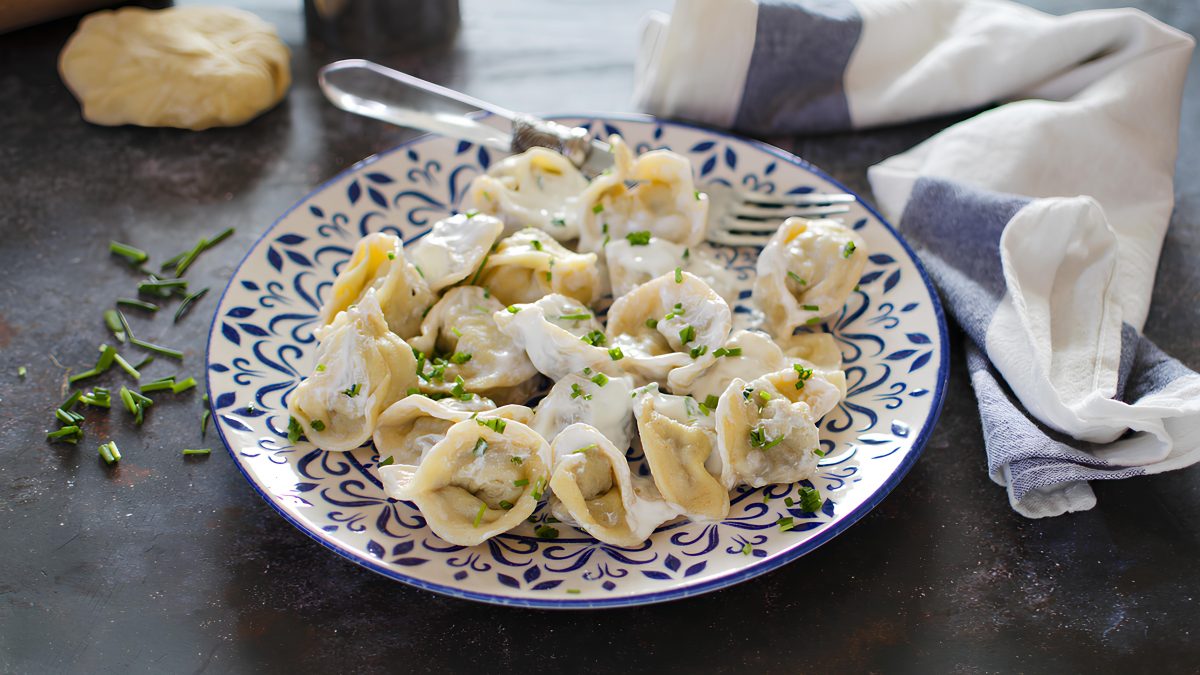
Pelmeni, or pel'meni, are stuffed ravioli typical of Russian cuisine, but also popular in Ukraine and in the countries of Central and Eastern Europe. They are small egg pasta cases filled with minced meat and which can be seasoned with melted butter, sour cream or mustard and vinegar, as is traditional in Siberia.
The preparation is similar to that of homemade ravioli, with a thin pastry made with flour, water, eggs and salt and a tasty filling based on minced meat: in the traditional Ural recipe, 45 percent beef, 35 percent lamb and 20 percent pork are used, cooked in a pan with onion and herbs, but you can choose any type of meat.
Some recipes call for frying the pelmeni after cooking, while in other cases a sort of flan is made in which the ravioli are seasoned with fresh liquid cream and sautéed mushrooms, sprinkled with grated parmesan and then cooked in the oven.
We offer you the original version of Russian pelmeni, boiled in water and then tossed with sour cream and chives: you can serve them at a themed dinner, along with other typical dishes such as beef Stroganoff, pirozhki and syrniki , the delicious sweet pancakes.
What Are Russian Pelmeni?
Russian pelmeni are traditional dumplings made from thin dough filled with minced meat, typically a mixture of beef, pork, or lamb, sometimes combined with onions and spices. Originating from the Ural region of Russia, pelmeni have deep roots in Siberian and Russian cuisine, believed to have been influenced by similar dumplings from Central Asia and China. Historically, pelmeni were a practical, hearty food that could be prepared in large batches and preserved frozen during harsh winters, making them a staple for travelers and hunters. Over time, pelmeni spread across Russia and neighboring countries, becoming a beloved comfort food. Their arrival in the United States came with waves of Russian and Eastern European immigrants, who brought their culinary traditions with them. Today, pelmeni enjoy growing popularity in the U.S., featured in Russian restaurants and increasingly embraced by food enthusiasts eager to explore international flavors.
How to Pronounce Pelmeni
The English pronunciation of pelmeni is typically said as "pel-MEH-nee" or "pel-MEN-ee."
Why Are Pelmeni So Popular in Russia?
Pelmeni hold a special place in Russian culture and cuisine because they perfectly suit the country’s climate, history, and lifestyle. Traditionally, Russia’s long, harsh winters made fresh food scarce, so pelmeni were ideal—they could be made in large batches, frozen, and stored for months, providing a convenient and nourishing meal during cold seasons. Their hearty meat filling offers much-needed energy and warmth, making them a comforting staple.
Moreover, pelmeni are incredibly versatile and easy to prepare—whether boiled, fried, or served with sour cream and vinegar, they cater to many tastes. Their simple yet satisfying flavor has made them a beloved family dish, often associated with home cooking and social gatherings. Because of these practical and cultural reasons, pelmeni have remained a cherished and popular food throughout Russia for centuries.
Pro Tips for The Best Russian Pelmeni
- For authentic, juicy filling, combine beef, pork, and sometimes lamb. The fat from pork keeps the filling tender and flavorful.
- Before assembling, refrigerate the meat mixture for at least 30 minutes. This helps the flavors meld and makes the filling easier to handle.
- A thin dough wrapper is key—it should be delicate but strong enough to hold the filling without tearing. Use a well-floured surface and roll evenly.
- Use just the right amount of filling (about a teaspoon) per pelmeni to avoid bursting during cooking.
- Press the edges firmly when folding and sealing pelmeni to prevent them from opening in boiling water.
- Cook pelmeni in plenty of salted water that’s at a gentle boil, stirring occasionally to prevent sticking.
What's The Difference Between Pelmeni and Pierogi and Dumplings?
Pelmeni are Russian dumplings typically filled with raw minced meat and boiled, known for their thin dough and hearty meat filling.
Pierogi, popular in Polish cuisine, often have thicker dough and are filled with a variety of ingredients like potatoes, cheese, or fruit; they can be boiled, fried, or baked.
Dumplings is a broad term used worldwide that includes many styles—from steamed or boiled dough parcels to fried varieties—with diverse fillings ranging from meat to vegetables and sweets.
What is The Best Meat for Pelmeni?
The best type of meat for pelmeni filling is typically a blend of ground beef and pork. This combination offers the perfect balance of flavor, fat content, and tenderness. Beef provides a rich, hearty taste, while pork adds juiciness and fat that keeps the filling moist and flavorful after cooking. Some recipes also include a bit of lamb for extra depth or even veal for a lighter texture. Using fresh, high-quality meat and finely chopping or grinding it yourself can elevate the taste of your pelmeni filling significantly.
What Else Can I Use as a Filling for Pelmeni?
Finely chopped onions and garlic add a subtle sweetness and mild kick, while fresh herbs like dill, parsley, or cilantro bring a burst of freshness. Spices such as black pepper, nutmeg, paprika, or cumin deepen the flavor profile.
For a different texture and taste, finely chopped mushrooms offer an earthy richness, and shredded cabbage can lighten the filling or be used on its own. Soft cheeses like farmer’s cheese or ricotta add creaminess, especially in vegetarian versions, and mashed potatoes make for a hearty alternative or complement.
Can I Fry Pelmeni?
Yes, you absolutely can fry pelmeni! Frying pelmeni gives them a deliciously crispy exterior while keeping the inside juicy and tender. Typically, pelmeni are boiled first until cooked through, then pan-fried in a bit of butter or oil until golden brown on both sides.
How Many Pelmeni Per Person?
Typically, you can expect to serve about 15 to 20 pelmeni per person as a main dish. This amount provides a satisfying portion since pelmeni are small but filling due to their meat content.
If you’re serving pelmeni as an appetizer or part of a larger meal with sides, around 8 to 12 pelmeni per person should be enough. Of course, appetite and context matter—if your guests love pelmeni or you want leftovers, you might want to prepare a bit more!
How Do I Keep Pelmeni From Opening While Boiling?
To prevent pelmeni from opening while boiling, it’s important to seal the edges firmly by pressing them tightly together, sometimes using a bit of water or beaten egg to help the dough stick better. Avoid overfilling the dumplings, as too much filling can stretch and tear the dough during cooking. Rolling the dough evenly thin yet strong enough to hold the filling is also key. When boiling, use gently simmering water rather than a rapid boil, and stir carefully to prevent the pelmeni from bumping into each other and breaking. Cooking them in plenty of water allows the dumplings to move freely without sticking, ensuring they stay intact and delicious.
Can I Make Them Ahead of Time?
Preparing them in advance is a common practice. After assembling the pelmeni, arrange them in a single layer on a baking sheet or tray and freeze until solid. Once frozen, transfer them to airtight freezer bags or containers. This way, you can store pelmeni for several months without losing quality.
When you’re ready to cook, simply boil or fry them straight from the freezer—no need to thaw. Making pelmeni ahead not only saves time but also ensures you always have a delicious, ready-to-cook meal on hand.
How to Store Russian Pelmeni
Place any leftover cooked pelmeni in an airtight container and refrigerate. They will keep well for 2 to 3 days.
To reheat, you can boil them briefly, pan-fry, or microwave until heated through.
Ingredients
How to Make Russian Pelmeni
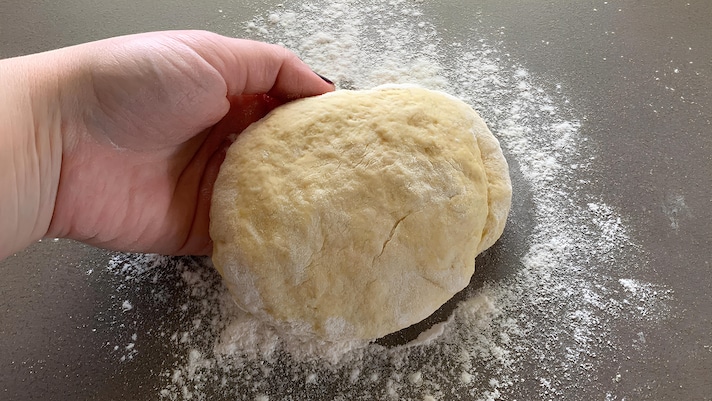
Prepare the dough: place the flour in a fountain shape on a pastry board, add the eggs to the center and start mixing with a fork. Then add the salt and water a little at a time, so that the dough absorbs the right amount. Work the ingredients until you obtain a smooth and homogeneous ball. Cover it with cling film and leave it to rest in the fridge for half an hour.
Prepare the dough: place the flour in a fountain shape on a pastry board, add the eggs to the center and start mixing with a fork. Then add the salt and water a little at a time, so that the dough absorbs the right amount. Work the ingredients until you obtain a smooth and homogeneous ball. Cover it with cling film and leave it to rest in the fridge for half an hour.
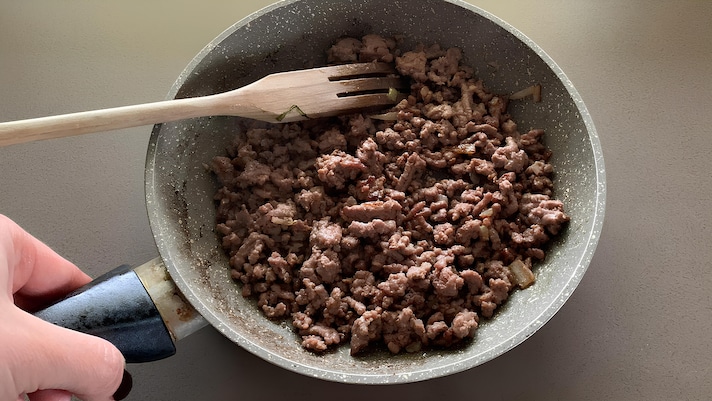
Now make the filling: in a pan, brown the chopped onion with extra virgin olive oil, then add the minced meat and let it flavor. Add salt, pepper and a little water, if necessary, to prevent the meat from sticking to the bottom. Cook for about 15 minutes, stirring often.
Now make the filling: in a pan, brown the chopped onion with extra virgin olive oil, then add the minced meat and let it flavor. Add salt, pepper and a little water, if necessary, to prevent the meat from sticking to the bottom. Cook for about 15 minutes, stirring often.
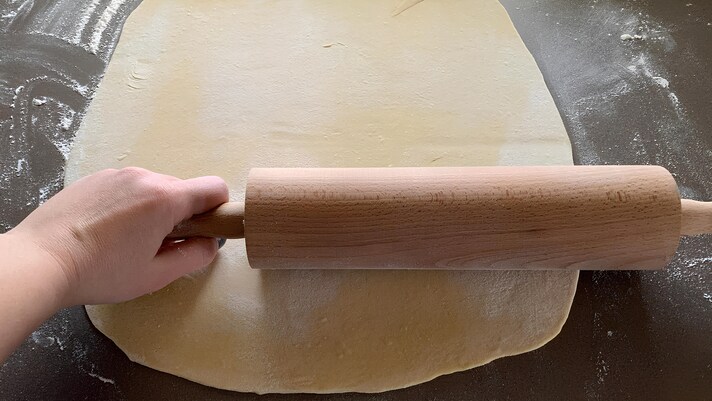
Take the dough, place it on a lightly floured work surface and roll it out with a rolling pin at a thickness of 2 millimeters.
Take the dough, place it on a lightly floured work surface and roll it out with a rolling pin at a thickness of 2 millimeters.
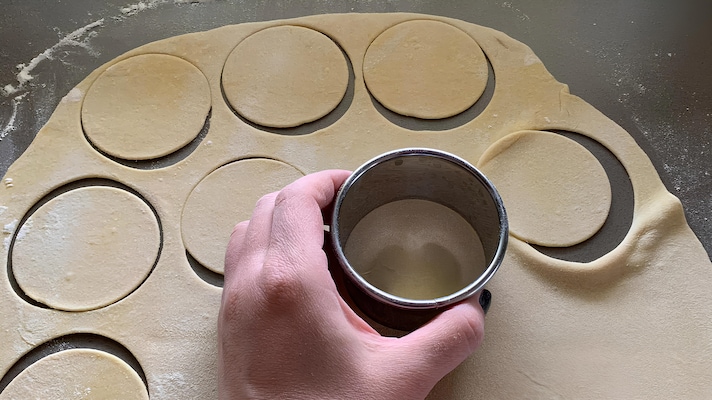
Using a pastry cutter, cut out circles of 8 centimetres in diameter.
Using a pastry cutter, cut out circles of 8 centimetres in diameter.
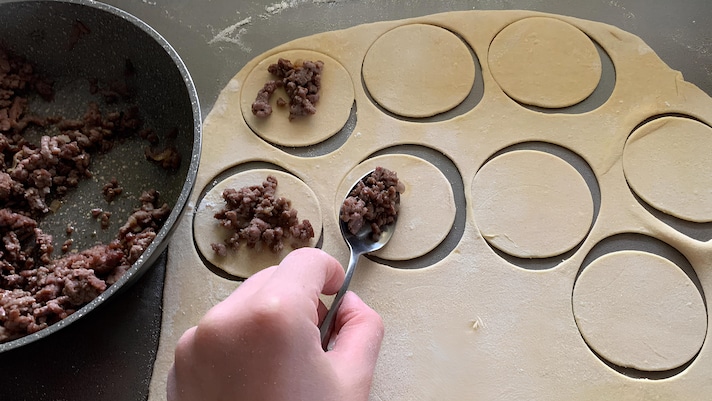
Place a teaspoon of filling in the center of each disk of dough.
Place a teaspoon of filling in the center of each disk of dough.
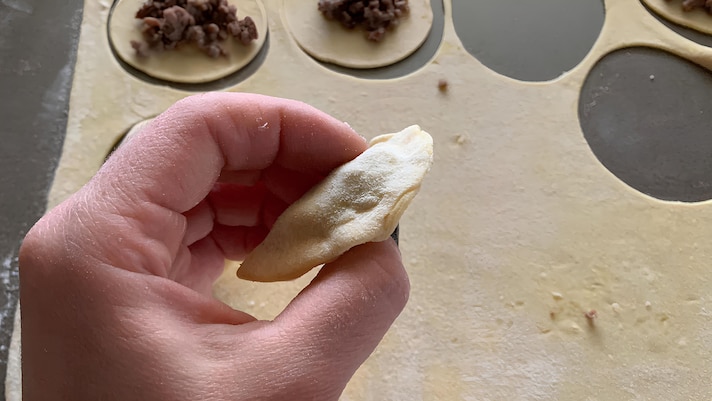
Cook the ravioli in boiling salted water for about 2 minutes, or until they float. Once ready, drain and season with sour cream and chopped chives.
Now close the ravioli by moistening the edges, overlapping the two ends and sealing well with your fingertips.
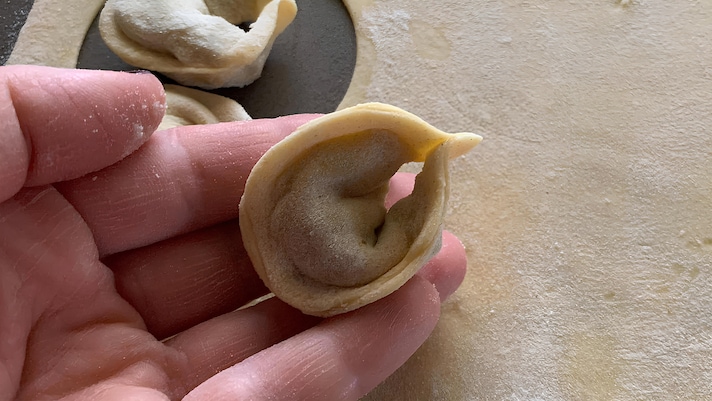
Enjoy!
Then match the final parts of the crescent obtained: you will have to create a sort of large tortello.
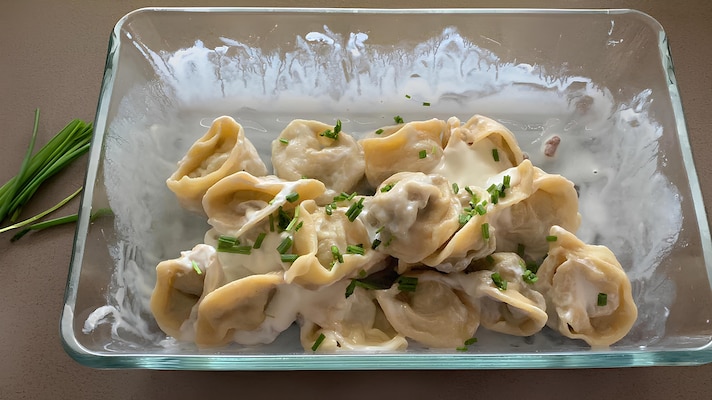
Cook the ravioli in boiling salted water for about 2 minutes, or until they float. Once ready, drain and season with sour cream and chopped chives.

Enjoy!
;Resize,width=767;)
